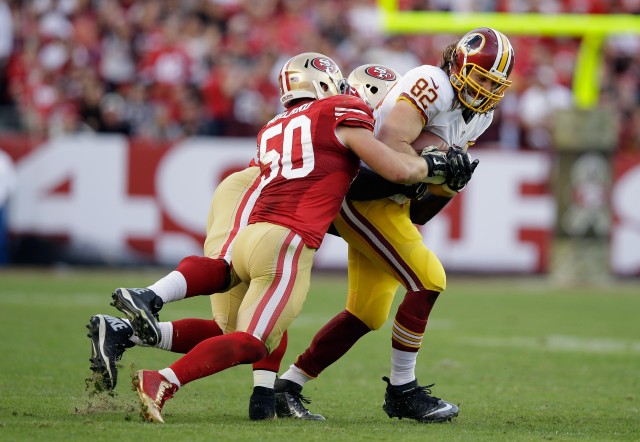49ers color analyst Tim Ryan, someone steeped in the game, couldn't help but betray a feeling of disbelief even as he praised Borland.
“That’s what is so shocking with Chris," he said on KNBR 680-AM. "You look at all the GMs and they go to the combines and do all the interviews. Usually when a player leaves the game with a very promising career in front of them, there are warning signs in their behavior and you kind of see it coming. That’s why you see the GMs go to the draft and ask all the questions. You always hear the famous quote: ‘This guy loves football. Football is important to him.’ With Borland, all of those things were right in your face, that he was all of that. That’s what makes this confusing – the guy was all ball, all the time."
The Concussion Issue
Concussion-induced brain trauma has been a dominant issue in football over the past several years. In 2013, the NFL agreed to pay more than 4,500 players $765 million to settle claims of ex-players who said they'd suffered from such injuries..
Brain damage was also at the center of a landmark $765 million settlement between the NFL and more than 4,500 players, which was granted preliminary but not final approval by a federal judge last year.
Under the settlement, all NFL players who retired prior to July 7, 2014, are eligible. From the NFL Concussion Settlement site, you can see the array of debilitating illnesses that NFL players have suffered:
The Settlement recognizes two separate groups (“Subclasses”) of Settlement Class Members based on the Retired NFL Football Player’s injury status prior to July 7, 2014:
Subclass 1 includes: Retired NFL Football Players who were not diagnosed with ALS, Parkinson’s Disease, Alzheimer’s Disease, Level 2 Neurocognitive Impairment (i.e., moderate Dementia), Level 1.5 Neurocognitive Impairment (i.e., early Dementia) or Death with CTE prior to July 7, 2014, and their Representative Claimants and Derivative Claimants.
Subclass 2 includes:
Retired NFL Football Players who were diagnosed with ALS, Parkinson’s Disease, Alzheimer’s Disease, Level 2 Neurocognitive Impairment (i.e., moderate Dementia), or Level 1.5 Neurocognitive Impairment (i.e., early Dementia) prior to July 7, 2014, and their Representative Claimants and Derivative Claimants; and
Representative Claimants of deceased Retired NFL Football Players who were diagnosed with ALS, Parkinson’s Disease, Alzheimer’s Disease, Level 2 Neurocognitive Impairment (i.e., moderate Dementia), or Level 1.5 Neurocognitive Impairment (i.e., early Dementia) prior to death or who died prior to July 7, 2014 and received a diagnosis of Death with CTE.
The concussion issue got further attention from the PBS documentary and related book "League of Denial," both of which explored the history of concussions in football, their devastating consequences, and what some would say was a cover-up by the NFL, which made $6 billion in revenue in the 2013-14 season.
The big question now: If a player has made this decision who had reached the very pinnacle of athletics, leaving potential fame and fortune only partially realized, what decisions will young players and their parents make, who have much less at stake?
A much publicized 2013 report by Steve Fainaru and Mark Fainaru-Wada, the authors of "League of Denial," said that youth participation in Pop Warner football had declined 9.5 percent between 2010-12. And an Associated Press-GFK poll last year found "nearly half of parents said they're not comfortable letting their child play football amid growing uncertainty about the long-term impact of concussions." But "only five percent ... said they have discouraged their child from playing in the last two years as concern over head injuries has increased at all levels of the game."
And high school football participation last year was actually up.
As for the NFL,in reaction to Borland's announcement, it said concussions were down 25 percent last year.
